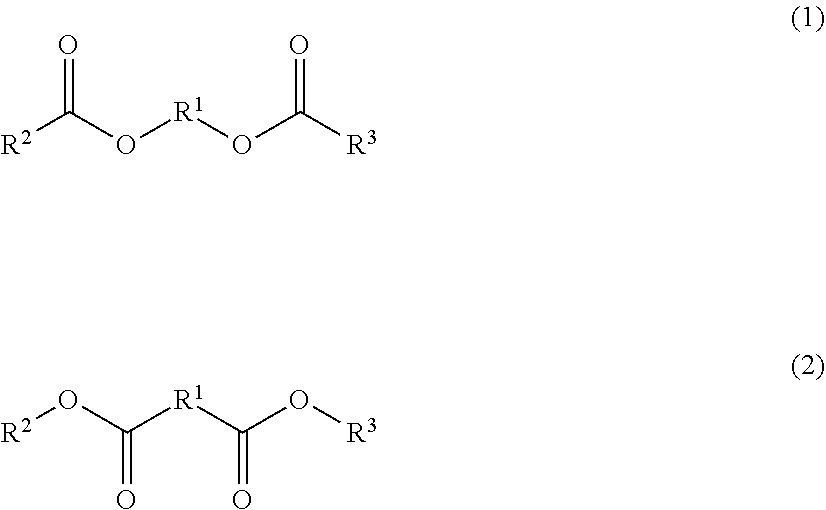Toner
a technology of toner and binder resin, applied in the field of toner, can solve the problems of reduced gloss of fixed image, important in image quality, insufficient melting of binder resin, etc., and achieve the effects of high image quality, improved mottling, and improved gloss of fixed imag
- Summary
- Abstract
- Description
- Claims
- Application Information
AI Technical Summary
Benefits of technology
Problems solved by technology
Method used
Image
Examples
production example 1
of Diester Compound
[0204]A total of 312.9 parts of stearic acid and 31 parts of ethylene glycol were added to a four-necked flask equipped with a thermometer, a nitrogen introducing tube, a stirrer and a cooling tube, and a reaction was conducted for 15 hours at normal pressure while distilling off the reaction water at 180° C. under a nitrogen stream. To 100 parts of the esterified crude product obtained by this reaction, 20 parts of toluene and 4 parts of ethanol were added. Furthermore, a 10% potassium hydroxide aqueous solution including potassium hydroxide in an amount corresponding to 1.5 times equivalent of the acid value of the crude esterified product was added followed by stirring at 70° C. for 30 min.
[0205]After stirring, the mixture was allowed to stand for 30 min, and then the esterified crude product was washed with water by removing the aqueous phase (lower layer) separated from the ester phase. The washing with water was repeated four times until the pH of the aqueou...
production example 2
of Diester Compound
[0206]A diester compound (2A) (distearyl succinate) was obtained in the same manner as in Production Example 1, except that in Production Example 1 of Diester Compound, 312.9 parts of stearic acid was changed to 118.1 parts of succinic acid, and 31 parts of ethylene glycol was changed to 148.7 parts of stearyl alcohol. The crystallization temperature of the diester compound (2A) was 65° C.
example 1
Preparation of Binder Resin Particle-Dispersed Solution
[0207]A total of 89.5 parts of styrene, 9.2 parts of butyl acrylate, 1.3 parts of acrylic acid as a monomer providing a carboxy group, and 3.2 parts of n-lauryl mercaptan were mixed and dissolved. To the solution obtained, an aqueous solution in which 1.5 parts of NEOGEN RK (Daiichi Kogyo Seiyaku Co., Ltd.) was dissolved in 150 parts of ion exchanged water was added and dispersed.
[0208]Further, an aqueous solution in which 0.3 parts of potassium persulfate was dissolved in 10 parts of ion exchanged water was added while stirring slowly for 10 min. After nitrogen substitution, emulsion polymerization was performed at 70° C. for 6 h. After completion of the polymerization, the reaction solution was cooled to room temperature, and ion exchange water was added to obtain a resin particle-dispersed solution having a solid fraction concentration of 12.5% by mass and a volume-based median diameter of 0.2 μm.
[0209]The resin constituting ...
PUM
| Property | Measurement | Unit |
|---|---|---|
| diameters | aaaaa | aaaaa |
| BET specific surface area | aaaaa | aaaaa |
| volume average particle diameter | aaaaa | aaaaa |
Abstract
Description
Claims
Application Information
 Login to View More
Login to View More - R&D
- Intellectual Property
- Life Sciences
- Materials
- Tech Scout
- Unparalleled Data Quality
- Higher Quality Content
- 60% Fewer Hallucinations
Browse by: Latest US Patents, China's latest patents, Technical Efficacy Thesaurus, Application Domain, Technology Topic, Popular Technical Reports.
© 2025 PatSnap. All rights reserved.Legal|Privacy policy|Modern Slavery Act Transparency Statement|Sitemap|About US| Contact US: help@patsnap.com



